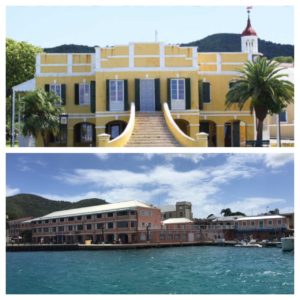Christiansted is arguably the most beautiful town in the Caribbean, but it’s more than just a pretty face. One admirer — the National Park Service no less — boasts that “no place in the Caribbean still demonstrates the architectural, economic, and political influence of Europe like the Christiansted National Historic Site.” The site is seven acres close to the Christiansted waterfront, and includes buildings constructed in the 17th and 18th centuries for St. Croix’s colonial society and its plantation economy. St. Croix’s history is dramatic, often heart-wrenching, and certainly worth investigation.
 Fort Christiansvaern was the first public building to be built by the Danes after they purchased St. Croix from France in 1733. The fort was built to pay homage to the Danish king and also to meet the urgent need to protect St. Croix against invasion from European powers, smugglers and pirates! The yellow-ochre color of the fort and other historic buildings is the color used to paint the Nyboder naval barracks in Copenhagen, planned and built by King Christian IV in the 18th century.
Fort Christiansvaern was the first public building to be built by the Danes after they purchased St. Croix from France in 1733. The fort was built to pay homage to the Danish king and also to meet the urgent need to protect St. Croix against invasion from European powers, smugglers and pirates! The yellow-ochre color of the fort and other historic buildings is the color used to paint the Nyboder naval barracks in Copenhagen, planned and built by King Christian IV in the 18th century.
Just across from the fort, an exhibit in the Steeple Building documents the religious history of St. Croix. The graceful steeple is a reminder of the Lutheran congregation that once held services there.
Next to the fort, the sweeping staircase of the Old Customs House provides excellent photo opportunities. The building is now home to the National Park Service offices and a wealth of information is available there.
The Old Scale House on the wharf displays the heavy-duty scale once used to weigh barrels of rum and sugar before shipment to Europe.
Governor General Peter von Scholten maintained his office and official residence in splendid fashion in majestic Government House on King Street.
Next to the Fort along the boardwalk is the King Christian hotel, which has been welcoming visitors to St. Croix for more than 200 years.
Finally, Danish architecture students are assisting the Virgin Islands government with the first phase of a project to restore the abandoned government building at the corner of Hospital St. and East End Rd. with the goal of housing the new UVI-affiliated School of Architecture in that building. Funding for the school will be split between sources in Denmark and in the Virgin Islands.
 Twice voted Best Real Estate Broker on St. Croix. Coldwell Banker President's Circle three years in a row.
Twice voted Best Real Estate Broker on St. Croix. Coldwell Banker President's Circle three years in a row. 